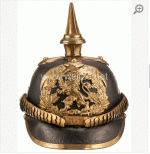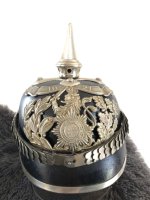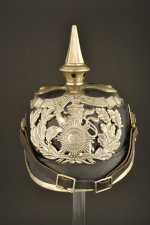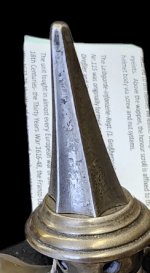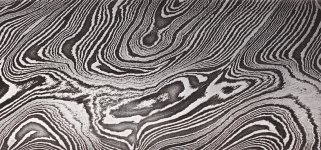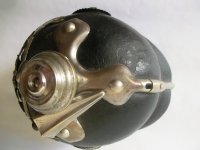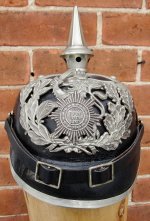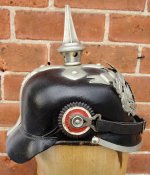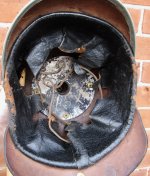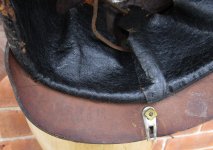I guess I should post my JR 115 here. It is the 1915 model as described by Clovis with the RBA XVIII marking on the rear visor. When I bought it decades ago, I had no knowledge of any 1915 model, I was just super happy to have a Hessen like the one of the front cover of Larcade’s vol.1. 
You are using an out of date browser. It may not display this or other websites correctly.
You should upgrade or use an alternative browser.
You should upgrade or use an alternative browser.
Hessen Leib Helmet and others
- Thread starter ccj
- Start date
CLOVIS 57
Well-known member
And finally, RBAXVIII helmets from 1915 can sometimes be seen... with a pre-war 115 M97 plate (reassembled from wartime circumstances).
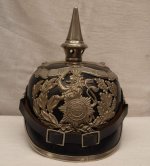
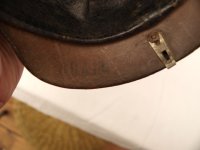
And vice versa. Mine, pictured above, is a pre-war schell, M97, reassembled with M15 trim and plate for RBA18115 RBA
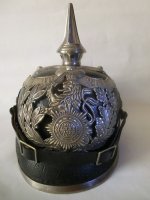
Although showing trim and the RBA model 1915 lion, it is not marked RBA, but JR115 1B. 19 ??
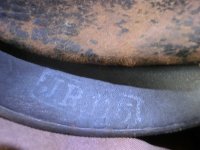
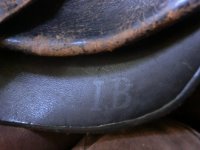
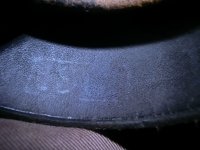 RBA18 trim and lion but marked JR115 IB 19xx vintage. This is confirmed by the interior stigmata:
RBA18 trim and lion but marked JR115 IB 19xx vintage. This is confirmed by the interior stigmata:
bomb shortened and stitching reworked. M91 side posts fitted with a single side latch (2 on the M95s).
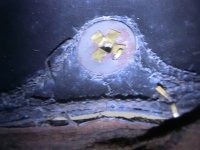
Trace of the old M71-91 rear spine upper fixing screw and of the fixing of the nut that now serves as the aerator.
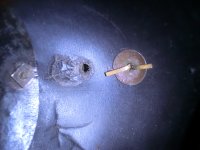


And vice versa. Mine, pictured above, is a pre-war schell, M97, reassembled with M15 trim and plate for RBA18115 RBA

Although showing trim and the RBA model 1915 lion, it is not marked RBA, but JR115 1B. 19 ??


 RBA18 trim and lion but marked JR115 IB 19xx vintage. This is confirmed by the interior stigmata:
RBA18 trim and lion but marked JR115 IB 19xx vintage. This is confirmed by the interior stigmata:bomb shortened and stitching reworked. M91 side posts fitted with a single side latch (2 on the M95s).

Trace of the old M71-91 rear spine upper fixing screw and of the fixing of the nut that now serves as the aerator.

Last edited:
John Josef
Well-known member
CLOVIS 57
Well-known member
Last edited:
Amybellars
Well-known member
Clovis thanks for the explanation to the difference.
I again will wait for an officer since Steve KAGGR has bought them all.
I again will wait for an officer since Steve KAGGR has bought them all.
CLOVIS 57
Well-known member
A distinction must be made between peacetime and wartime production :Whats the typical material used for manufacture of the enlisted mans spike and wappen?
***Pre-war helmets of the enlisted mans M1895 :
---Helmets with "gold" trim were made of brass
Brass, sometimes called yellow copper or yellow bronze, is a metal alloy composed essentially of (red) copper (symbol Cu) and zinc (symbol Zn), in variable proportions, with possibly other associated metals such as lead, tin, nickel, chromium or magnesium (white or light grey metals). The front plates (like the Prussian infantry eagles) were sometimes gilded.
In theory, the linings of M95 helmets should have been made of Tombac, i.e. an alloy with more copper-red than brass. In practice, only a few plates or linings were made from this metal, such as some very red Württemberg or Bavarian plates.
---Helmets with "silver" trimmings were made of nickel silver, which is an alloy with more white metals and less red copper. Nickel silver is an alloy of copper, zinc, nickel and sometimes lead in very small quantities, appreciated for its silvery appearance or metallic white sheen, and for this reason is sometimes called argentan or alpaca. Front plates (such as Pionniers Prussian eagles) were sometimes silvered or treated with Berlin White.
***---Post mobilization helmets of the enlisted mans M1914 :
Given the continental blockade imposed on Germany and the shortage of semi-precious metals, "ersatz" alloys appeared, known as "Kriegsmetal". Even for officers, gold-plated brass was replaced by zinc or gold-plated iron.
---Helmets with "gold" trim were made of brass, (old M95) or copper-aluminium, and even brass-plated iron (war production).
---Helmets with "silver" fittings were made of nickel silver ( old M95) Après 1914, alloy of antimony, zinc, tin or lead with little or no copper, lower quality nickel silver. Ersatz" production also included brass tips and fittings (many of which were still in stock), but nickel-plated to give them a "silver" appearance, as requested by the Leib-régiments and the Pionniers.
Post-1914 helmets, such as the 115 Hessian and the 109 Badois, show the most deviation from the quality of "precious" alloys. The other regiments were "standardised" with the standard model 15, in grey-painted iron.
Hi Clovis,In theory, the linings of M95 helmets should have been made of Tombac, i.e. an alloy with more copper-red than brass. In practice, only a few plates or linings were made from this metal
I think almost all M95 Wappen were made of Tombak (this applies to the brass-coloured Wappen only of course
In the German language Tombak is not necessarily a reddish brass, rather it is defined as brass containing a certain amount of copper (more than 67% according to Wikipedia). Only with very high concentrations of copper the brass becomes reddish, and with concentrations between 85-90% it will appear "golden", below that more yellowish.
In the "Reglement über die Bekleidung und Ausrüstung der Truppen im Frieden",1855, Beilage Tabelle I, page 204, (and again in the 1868 version) the Wappen of some of the Guard regiments are defined as "Tombachne", yet I have not seen any reddish Wappen from that era.
I'm not sure where the association of "tombac" with reddish brass comes from, when I do an internet search for "tombac" it is mainly gold- and yellow-coloured brass that is shown.
Regards,
Lars
CLOVIS 57
Well-known member
Thank you Lars for your involvement. In fact the alloy "tombac", "brass" or "nickel silver" is more or less made with the same metals but :
---the less copper there is, the more the alloy changes from "red" to "white".
Note that the colour of the tombac can range from red to yellow. Here are a few examples of different tombacs:
Tombac - Wikipedia
en.wikipedia.org en.wikipedia.org
Red tombac from Paris
Copper 90%, Zinc 7.9%, Lead 1.5
Vienna red tombstone
Copper 97.8%, Zinc 2.2
The colour of the tombac can range from red to yellow. Here are a few examples of different red tombacs:
Paris red tombac
Copper 90%, Zinc 7.9%, Lead 1.5
Vienna red tombac
Copper 97.8%, Zinc 2.2
If I take the crest of the M62 cuirassier helmet, it is red, so tombac. The M89/94 is yellow, so brass:
Infra: M67 tombac schell, brass scales. The schell should be about 95% copper.
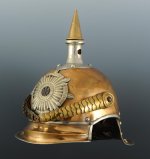
Infra M89/94 brass schell and scales, maillechort lion :
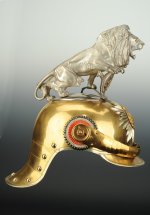
---the less copper there is, the more the alloy changes from "red" to "white".
Note that the colour of the tombac can range from red to yellow. Here are a few examples of different tombacs:
Tombac - Wikipedia
en.wikipedia.org en.wikipedia.org
Red tombac from Paris
Copper 90%, Zinc 7.9%, Lead 1.5
Vienna red tombstone
Copper 97.8%, Zinc 2.2
The colour of the tombac can range from red to yellow. Here are a few examples of different red tombacs:
Paris red tombac
Copper 90%, Zinc 7.9%, Lead 1.5
Vienna red tombac
Copper 97.8%, Zinc 2.2
If I take the crest of the M62 cuirassier helmet, it is red, so tombac. The M89/94 is yellow, so brass:
Infra: M67 tombac schell, brass scales. The schell should be about 95% copper.

Infra M89/94 brass schell and scales, maillechort lion :

Last edited:
Sandmann
Well-known member
The materials were specified in the clothing regulations. Before 1895, the gold parts of Prussian helmets were usually made of tombac for the guards and brass for the others. The silver parts were always made of nickel silver. After 1895, the emblems were always made of tombac, the fittings and chinscales of aluminum bronze (shortly invented). Exceptions were the mounted troops such as the field artillery and dragoons, who were specified to wear emblem, fittings and chinscales made of tombac or brass.
For Hessian troops before 1895 the gold parts of all troops (fittings, emblems and chinscales) were only made of brass. After 1895 the rules were identical to Prussia, except the gold parts of mounted troops which continued to be made of brass only.
In earlier times the fittings were often gilded or silver plated, but later this was only the case for officer helmets. Exceptions were privat purchased helmets, which were often gilded or silver plated for enlisted men‘s as well.
For Hessian troops before 1895 the gold parts of all troops (fittings, emblems and chinscales) were only made of brass. After 1895 the rules were identical to Prussia, except the gold parts of mounted troops which continued to be made of brass only.
In earlier times the fittings were often gilded or silver plated, but later this was only the case for officer helmets. Exceptions were privat purchased helmets, which were often gilded or silver plated for enlisted men‘s as well.
Thanks Clovis,Note that the colour of the tombac can range from red to yellow. Here are a few examples of different tombacs:
The tombac compositions you show all have a (very) high in copper content, hence the redness, but I think that the Bekleidungsordnung is referring to the golden-coloured tombac for the 1895 Wappen (which is why red Wappen are very rare
Regards,
Lars
Sandmann
Well-known member
On the subject of tombac and brass:
I think it is difficult to know whether it is tombac or brass, as tombac is a subspecies of brass and, as Lars correctly wrote, was also used in yellowish tones. According to the "chemistry school", brass with a copper content of >67% is called tombac. I therefore assume that tombac was also used for the emblems when it was specified in the clothing regulations. However, as brass and tombac both have a high copper content, it is very difficult to clearly identify the materials after so many years of oxidation. I think we would need an X-ray fluorescence analysis to be sure.
I think it is difficult to know whether it is tombac or brass, as tombac is a subspecies of brass and, as Lars correctly wrote, was also used in yellowish tones. According to the "chemistry school", brass with a copper content of >67% is called tombac. I therefore assume that tombac was also used for the emblems when it was specified in the clothing regulations. However, as brass and tombac both have a high copper content, it is very difficult to clearly identify the materials after so many years of oxidation. I think we would need an X-ray fluorescence analysis to be sure.
John Josef
Well-known member
Hi Brain , add another admirer of that one she's a real beauty 
My thanks to all for their comments. I just noticed that the spike base pins have screw posts and brass nuts similar to the Clovis example. This seems unusual for an M15 produced helmet. I also see that the wappen has all of the characteristics outlined by Clovis. 
Last edited:

